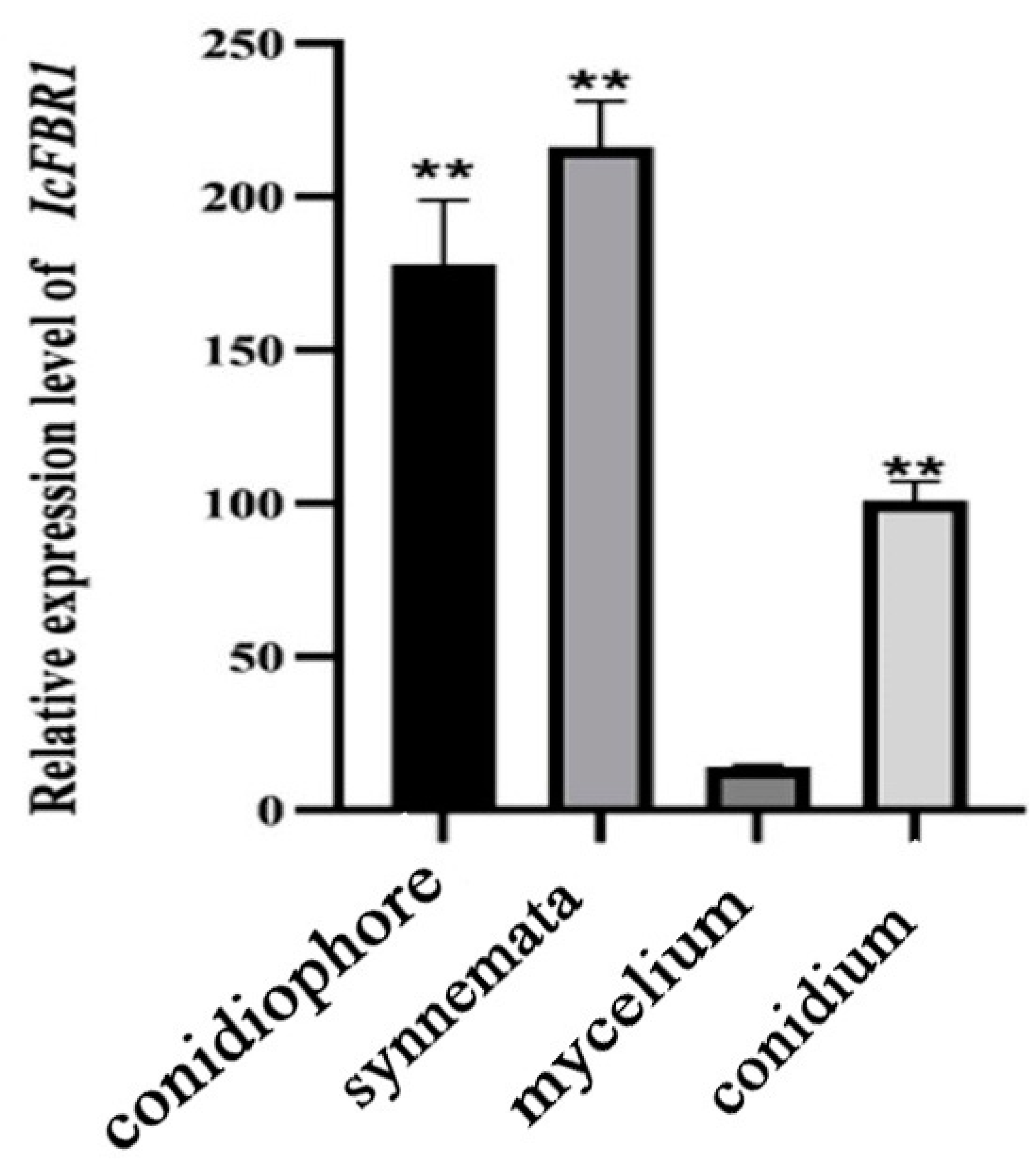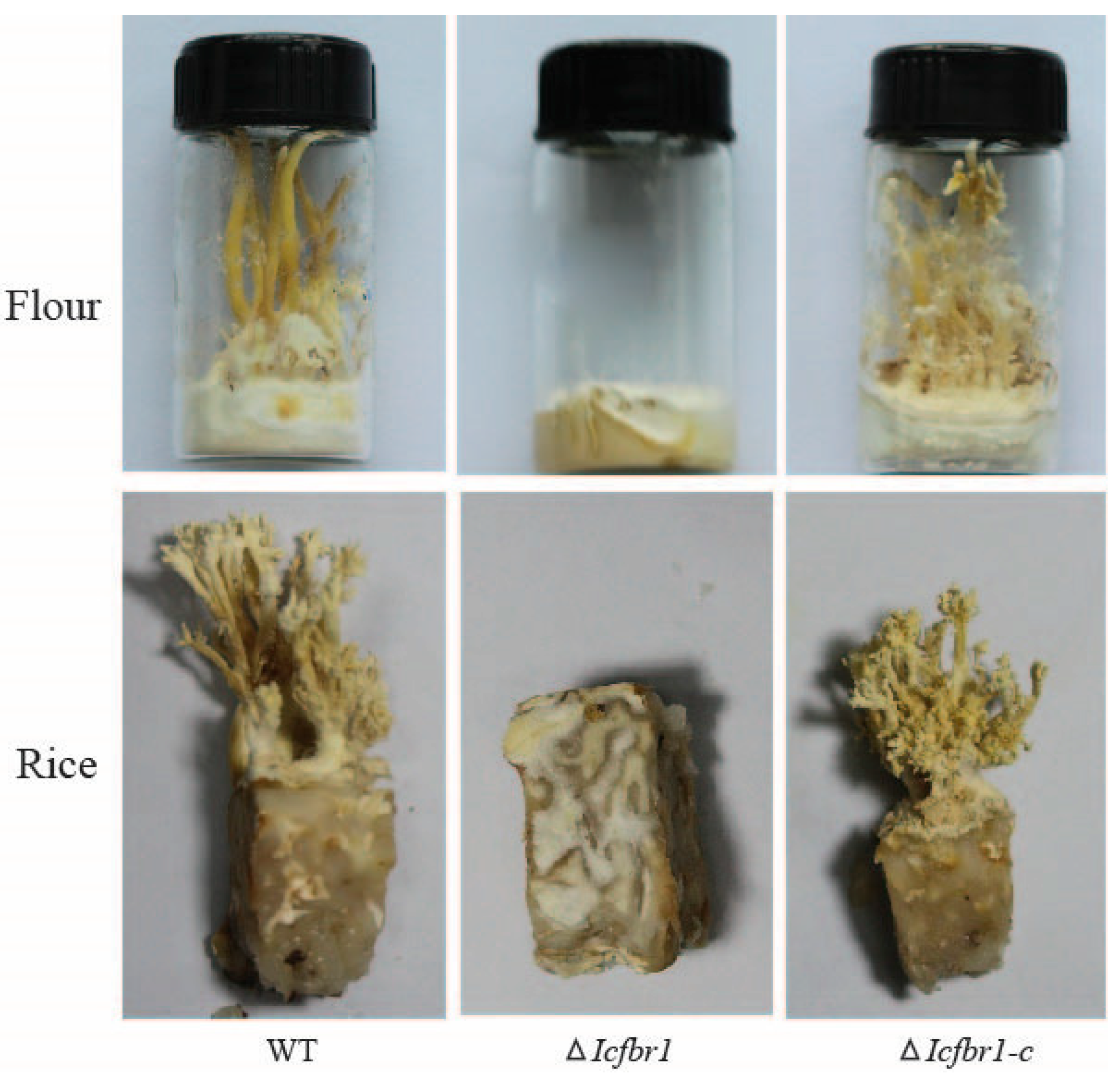GPI-Anchored Protein Homolog IcFBR1 Functions Directly in Morphological Development of Isaria cicadae
Abstract
1. Introduction
2. Materials and Methods
2.1. Fungal Strains, Vectors, and Culture Conditions
2.2. ATMT Transformation and TAIL-PCR
2.3. Vector Construction and Verification of Mutant
2.4. Effects of IcFBR1 on Nutrition Utilization and Phenotypic Characterization
2.5. Observation of Fluorescence Fusion Proteins in I. cicadae and Quantitative Real-Time PCR
2.6. Lipid Droplet Stain with BODIPY
2.7. Assay of Determination of Polysaccharide and Enzyme Activity
2.8. Effects of IcFBR1 on the Growth and Formation of Synnema
2.9. Transcriptome Analysis
2.10. Statistical Analysis
3. Results
3.1. The IcFBR1 Gene Screening in I. cicadae
3.2. Validation of Gene Knockout Mutants
3.3. IcFBR1 Is Involved in the Development of I. cicadae
3.4. IcFBR1 Is Involved in the Utilization of Carbon Sources by I. cicadae
3.5. IcFBR1 Has No Effect on the Integrity of the Cell Wall of I. cicadae
3.6. Expression of GFP-Tagged IcFBR1 in Different Stages of I. cicadae Life Cycle
3.7. Effects of IcFBR1 on I. cicadae Key Metabolites
3.8. IcFBR1 Is Involved in the Formation of Synnemata
3.9. Transcriptome Analysis
4. Discussion
5. Conclusions
Supplementary Materials
Author Contributions
Funding
Institutional Review Board Statement
Data Availability Statement
Acknowledgments
Conflicts of Interest
References
- Takano, F.; Yahagi, N.; Yahagi, R.; Takada, S.; Ohta, T. The liquid culture filtrates of (peck) samson (=yasuda) and (miquel) samson (=(berk.) llond) regulate th1 and th2 cytokine response in murine peyer’s patch cells in vitro and ex vivo. Int. Immunopharmacol. 2005, 5, 903–916. [Google Scholar] [CrossRef] [PubMed]
- Hsu, J.H.; Jhou, B.Y.; Yeh, S.H.; Chen, Y.L. Healthcare functions of Cordyceps cicadae. J. Nutr. Food Sci. 2015, 5, 432. [Google Scholar] [CrossRef]
- Wang, Q.; Liu, Z.Y. Advances in studies on medicinal fungi Cordyceps cicadae. Chin. Tradit. Herb. Drugs 2004, 35, 469–471. [Google Scholar]
- Li, C.R.; Wang, Y.Q.; Cheng, W.M.; Chen, Z.A.; Hywel-Jones, N.; Li, Z.Z. Review on research progress and prospects of Cicada flower, Isaria cicadae (Ascomycetes). Int. J. Med. Mushrooms 2021, 23, 81–91. [Google Scholar] [CrossRef]
- He, Y.; Zhang, W.; Peng, F.; Lu, R.; Zhou, H.; Bao, G.; Wang, B.; Huang, B.; Li, Z.; Hu, F. Metabolomic variation in wild and cultured cordyceps and mycelia of Isaria cicadae. Biomed. Chromatogr. 2019, 33, e4478. [Google Scholar] [CrossRef]
- Weng, S.C.; Chou, C.J.; Lin, L.C.; Tsai, W.J.; Kuo, Y.C. Immunomodulatory functions of extracts from the Chinese medicinal fungus Cordyceps cicadae. J. Ethnopharmacol. 2002, 83, 79–85. [Google Scholar] [CrossRef]
- Jin, L.Q.; Jian-Xin, L.U.; Yang, J.Z. Experimental study on the regulative effect of Paecilomyces total polysaccharides on immunologic function in old rats. Chin. J. Gerontol. 2005, 25, 82–84. [Google Scholar]
- Yang, J.Z.; Jia, Z.; Chen, B.K.; Jin, L.Q.; Li, L.J. Regulating effects of Paecilomyces cicadae polysaccharides on immunity of aged rats. China J. Chin. Mater. Med. 2008, 33, 292–295. [Google Scholar]
- Jin, Z.; Chen, Y. Clinical observation on Cordyceps cicadae shing tang in preventing the progression of chronic renal failure. Chin. Arch. Tradit. Chin. Med. 2006, 24, 1457–1459. [Google Scholar]
- Liu, K.; Wang, F.; Liu, G.; Dong, C. Effect of Environmental Conditions on Synnema Formation and Nucleoside Production in Cicada Flower, Isaria cicadae (Ascomycetes). Int. J. Med. Mushrooms 2019, 21, 59–69. [Google Scholar] [CrossRef]
- Song, J.M.; Xin, J.C.; Zhu, Y. Effect of Cordyceps cicadae on blood sugar of mice and its hematopoietic function. Chin. Arch. Tradit. Chin. Med. 2007, 25, 1144–1145. [Google Scholar]
- Cai, J.F.; Jiang, Z.M.; Hong-Yang, L.U.; Bo-Zheng, L.U. Research of anti-tumor effects of different purified components of Cordyceps cicadaein in vitro. Chin. Arch. Tradit. Chin. Med. 2010, 28, 760–764. [Google Scholar]
- Cheng, D.; Pan, P.; Yan, Z.; Zhou, F.; Chen, Y. The parasitic fungus Paecilomyces cicadae from the cicadae flower and its anti-HSV activity. Asian J. Tradit. Med. 2009, 6, 214–219. [Google Scholar]
- Samalova, M.; Carr, P.; Bromley, M.; Blatzer, M.; Mouyna, I. GPI Anchored Proteins in Aspergillus fumigatus and Cell Wall Morphogenesis. Fungal Cell Wall 2020, 425, 167–186. [Google Scholar]
- Fontaine, T. Sphingolipids from the human fungal pathogen Aspergillus fumigatus. Biochimie 2017, 141, 9–15. [Google Scholar] [CrossRef]
- Bruneau, J.M.; Magnin, T.; Tagat, E.; Legrand, R.; Bernard, M.; Diaquin, M.; Fudali, C.; Latge, J.P. Proteome analysis of Aspergillus fumigatus identifies glycosylphosphatidylinositol-anchored proteins associated to the cell wall biosynthesis. Electrophoresis 2001, 22, 2812–2823. [Google Scholar] [CrossRef]
- Li, J.; Mouyna, I.; Henry, C.; Moyrand, F.; Malosse, C.; Chamot-Rooke, J.; Janbon, G.; Latgé, J.-P.; Fontaine, T. Glycosylphosphatidylinositol anchors from galactomannan and gpi-anchored protein are synthesized by distinct pathways in Aspergillus fumigatus. J. Fungi 2018, 4, 19. [Google Scholar] [CrossRef]
- Nagy, L.G.; Kovács, G.M.; Krizsán, K. Complex multicellularity in fungi: Evolutionary convergence, single origin, or both? Biol. Rev. Camb. Philos. Soc. 2018, 93, 1778–1794. [Google Scholar] [CrossRef]
- Labourel, A.; Frandsen, K.; Zhang, F.; Brouilly, N.; Berrin, J.G. A fungal family of lytic polysaccharide monooxygenase-like copper proteins. Nat. Chem. Biol. 2020, 16, 345–350. [Google Scholar] [CrossRef]
- Fan, W.W.; Zhang, S.; Zhang, Y.J. The complete mitochondrial genome of the Chan-hua fungus Isaria cicadae: A tale of intron evolution in Cordycipitaceae. Environ. Microbiol. 2019, 21, 864–879. [Google Scholar] [CrossRef]
- Lu, Y.; Luo, F.; Kai, C.; Xiao, G.; Ying, Y.; Li, C.; Li, Z.; Shuai, Z.; Zhang, H.; Wang, C. Omics data reveal the unusual asexual-fruiting nature and secondary metabolic potentials of the medicinal fungus Cordyceps cicadae. BMC Genom. 2017, 18, 668. [Google Scholar] [CrossRef] [PubMed]
- Chen, L.; Wang, Q.; Chen, H.; Sun, G.; Liu, H.; Wang, H.K. Agrobacterium tumefaciens-mediated transformation of Botryosphaeria dothidea. World J. Microbiol. Biotechnol. 2016, 32, 106. [Google Scholar] [CrossRef] [PubMed]
- Mullins, E.D.; Chen, X.; Romaine, P.; Raina, R.; Kang, S. Agrobacterium-mediated transformation of Fusarium oxysporum: An efficient tool for insertional mutagenesis and gene transfer. Phytopathology 2001, 91, 173–180. [Google Scholar] [CrossRef] [PubMed]
- Lu, J.; Cao, H.; Zhang, L.; Huang, P.; Lin, F. Systematic analysis of Zn2Cys6 transcription factors required for development and pathogenicity by high-throughput gene knockout in the rice blast fungus. PLoS Pathog. 2014, 10, e1004432. [Google Scholar] [CrossRef]
- Qu, Y.; Wang, J.; Zhu, X.; Dong, B.; Lin, F. The P5-type ATPase Spf1 is required for development and virulence of the rice blast fungus Pyricularia oryzae. Curr. Genet. 2019, 66, 385–395. [Google Scholar] [CrossRef]
- Zhang, Q.; Li, Y.; Zong, S.; Ye, M. Optimization of fermentation of Fomes fomentarius extracellular polysaccharide and antioxidation of derivatized polysaccharides. Cell. Mol. Biol. 2020, 66, 56–65. [Google Scholar] [CrossRef]
- Jiang, K.; Han, R. Rhf1 gene is involved in the fruiting body production of Cordyceps militaris fungus. J. Ind. Microbiol. Biotechnol. 2015, 42, 1183–1196. [Google Scholar] [CrossRef]
- Andrews, S. FastQC: A Quality Control Tool for High Throughput Sequence Data; Babraham Bioinformatics: Cambridge, UK, 2014. [Google Scholar]
- Bolger, A.M.; Marc, L.; Bjoern, U. Trimmomatic: A flexible trimmer for Illumina sequence data. Bioinformatics 2014, 30, 2114–2120. [Google Scholar] [CrossRef]
- Anders, S.; Pyl, P.T.; Huber, W. HTSeq—A Python framework to work with high-throughput sequencing data. Bioinformatics. 2015, 31, 166–169. [Google Scholar] [CrossRef]
- Love, M.I.; Huber, W.; Anders, S. Moderated estimation of fold change and dispersion for RNA-seq data with DESeq2. Genome Biol. 2014, 15, 550. [Google Scholar] [CrossRef]
- Conesa, A.; Gotz, S.; Garcia-Gomez, J.M.; Terol, J.; Talon, M.; Robles, M. Blast2GO: A universal tool for annotation, visualization and analysis in functional genomics research. Bioinformatics 2005, 21, 3674–3676. [Google Scholar] [CrossRef] [PubMed]
- Jia, Y.; Yong, Z.; Cui, H.; Liu, J.; Wu, Y.; Yun, C.; Xu, H.; Huang, X.; Li, S.; An, Z. WEGO 2.0: A web tool for analyzing and plotting GO annotations, 2018 update. Nucleic Acids Res. 2018, 46, W71–W75. [Google Scholar]
- Minoru, K.; Yoko, S.; Masayuki, K.; Miho, F.; Mao, T. KEGG as a reference resource for gene and protein annotation. Nucleic Acids Res. 2015, 44, D457–D462. [Google Scholar]
- Stleger, R.J.; Butt, T.M.; Staples, R.C.; Roberts, D.W. Synthesis of proteins including a cuticle-degrading protease during differentiation of the entomopathogenic fungus metarhizium anisopliae. Exp. Mycol. 1989, 13, 253–262. [Google Scholar] [CrossRef]
- Paterson, R.R.M. Cordyceps: A traditional chinese medicine and another fungal therapeutic biofactory? Phytochemistry 2008, 69, 1469–1495. [Google Scholar] [CrossRef]
- Wang, F.; Song, X.; Dong, X.; Zhang, J.; Dong, C. DASH-type cryptochromes regulate fruiting body development and secondary metabolism differently than CmWC-1 in the fungus Cordyceps militaris. Appl. Microbiol. Biot. 2017, 101, 4645–4657. [Google Scholar] [CrossRef]
- Zhang, J.; Wang, F.; Yang, Y.; Wang, Y.; Dong, C. CmVVD is involved in fruiting body development and carotenoid production and the transcriptional linkage among three blue-light receptors in edible fungus Cordyceps militaris. Environ. Microbiol. 2020, 22, 466–482. [Google Scholar] [CrossRef]
- Wang, Y.; Wang, R.; Li, Y.; Yang, R.H.; Gong, M.; Shang, J.J.; Zhang, J.S.; Mao, W.J.; Zhou, G.; Bao, D.P. Diverse function and regulation of CmSnf1 in entomopathogenic fungus Cordyceps militaris. Fungal Genet. Biol. 2020, 142, 103415. [Google Scholar] [CrossRef]
- Green, K.A.; Becker, Y.; Tanaka, A.; Takemoto, D.; Fitzsimons, H.L.; Seiler, S.; Lalucque, H.; Silar, P.; Scott, B. Symb and symc, two membrane associated proteins, are required for epichlo festucae hyphal cell–cell fusion and maintenance of a mutualistic interaction with lolium perenne. Mol. Microbiol. 2017, 103, 657–677. [Google Scholar] [CrossRef]
- Garcia-Santamarina, S.; Probst, C.; Festa, R.A.; Chen, D.; Thiele, D.J. A lytic polysaccharide monooxygenase-like protein functions in fungal copper import and meningitis. Nat. Chem. Biol. 2020, 16, 337–344. [Google Scholar] [CrossRef]
- Sakamoto, Y.; Irie, T.; Sato, T. Isolation and characterization of a fruiting body-specific exo-β-1,3-glucanase-encoding gene, exg1, from Lentinula edodes. Curr. Genet. 2005, 47, 244–252. [Google Scholar] [CrossRef] [PubMed]
- Ueki, T.; Inouye, S. Identification of an activator protein required for the induction of fruA, a gene essential for fruiting body development in Myxococcus xanthus. Proc. Natl. Acad. Sci. USA 2003, 100, 8782–8787. [Google Scholar] [CrossRef] [PubMed]
- Masato, Y.; Michihisa, K.; Satoshi, I.; Goro, T.; Mitsuo, O.; Makoto, S. Isolation and characterization of a gene coding for chitin deacetylase specifically expressed during fruiting body development in the basidiomycete Flammulina velutipes and its expression in the yeast Pichia pastoris. FEMS Microbiol. Lett. 2008, 2, 130–137. [Google Scholar]







Publisher’s Note: MDPI stays neutral with regard to jurisdictional claims in published maps and institutional affiliations. |
© 2022 by the authors. Licensee MDPI, Basel, Switzerland. This article is an open access article distributed under the terms and conditions of the Creative Commons Attribution (CC BY) license (https://creativecommons.org/licenses/by/4.0/).
Share and Cite
Li, D.; Gai, Y.; Meng, J.; Liu, J.; Cai, W.; Lin, F.-C.; Wang, H. GPI-Anchored Protein Homolog IcFBR1 Functions Directly in Morphological Development of Isaria cicadae. J. Fungi 2022, 8, 1152. https://doi.org/10.3390/jof8111152
Li D, Gai Y, Meng J, Liu J, Cai W, Lin F-C, Wang H. GPI-Anchored Protein Homolog IcFBR1 Functions Directly in Morphological Development of Isaria cicadae. Journal of Fungi. 2022; 8(11):1152. https://doi.org/10.3390/jof8111152
Chicago/Turabian StyleLi, Dong, Yunpeng Gai, Junlong Meng, Jingyu Liu, Weiming Cai, Fu-Cheng Lin, and Hongkai Wang. 2022. "GPI-Anchored Protein Homolog IcFBR1 Functions Directly in Morphological Development of Isaria cicadae" Journal of Fungi 8, no. 11: 1152. https://doi.org/10.3390/jof8111152
APA StyleLi, D., Gai, Y., Meng, J., Liu, J., Cai, W., Lin, F.-C., & Wang, H. (2022). GPI-Anchored Protein Homolog IcFBR1 Functions Directly in Morphological Development of Isaria cicadae. Journal of Fungi, 8(11), 1152. https://doi.org/10.3390/jof8111152






